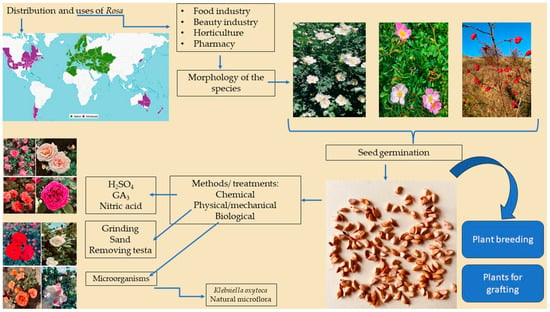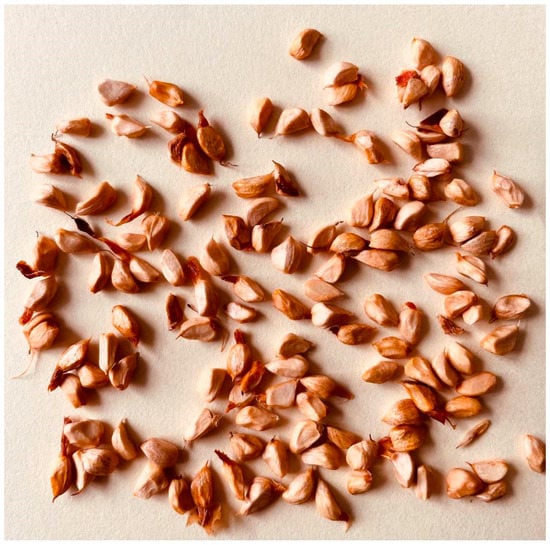2. The Factors Influencing Germination within the Rosa Genus
Regarding higher plants’ ability to survive as species, the seed stage is crucial. It is the plant’s dispersal unit that may endure the time between the maturity of the seed and the establishment of the following generation as a seedling once it has germinated. The seed, which is primarily in a dry state for its survival, is well-equipped to withstand prolonged durations under unfavorable conditions. The seed goes into dormancy to maximize germination over time
[11][24]. Additionally, dormancy stops pre-harvest germination. To comprehend how different environmental conditions and applied chemicals regulate germination, numerous investigations have been carried out. However, very little is still known about the process by which the rose embryo emerges from the seed to complete germination and how embryo emergence is blocked in dormant seeds
[12][25]. Seed dormancy has been defined as the incapacity of a viable seed to germinate under favorable conditions
[12][13][25,26]. In roses, hips typically contain between one and thirty seeds, and hip set and seed germination are frequently less than 50%
[14][27]. In the breeding of cut and garden roses, mature hips are collected in late September and early October, or 3–4 months following pollination. Hips are used to collect and count seeds. After that, seeds are stored for roughly 6–12 weeks at 2–5 °C and a moderate moisture level. Seeds can be sown directly in the germination substrate for vernalization, depending on the environment; otherwise, preservation in a cold chamber is required. A modern cut rose breeding program is thought to get off to a strong start with 120,000 seedlings after germination. Seeds are often sown on germination beds or benches at a density that can range from 150 to 400 seeds per square meter, depending on the available space and the number of seeds to start with. After two months, the vernalization period is deemed to be over
[15][28]. Seeds of the
Rosa genus are typically small, irregularly shaped (4.5–6 mm long), and vary in color depending on the species and variety (
Figure 2). They are enclosed within a protective seed coat, which can range from smooth to slightly textured.
Rosa seeds are generally characterized by their hard seed coat, which contributes to seed dormancy. The pericarp epi-, meso-, and endocarp layers make up a rose achene; the last structure is extremely impervious to water absorption (unpublished data). Therefore, the endocarpic layer may serve as a tegument-type physical barrier to achene germination
[16][17].
Figure 2.
Rosa canina
seeds. The seeds were obtained from fruits collected from the spontaneous flora of Transylvania, northwestern Romania (photo by R.L.S.-D.).
The seed coat protects the embryo but can present problematic challenges for germination. However,
Rosa seeds also possess the potential resources for germination and subsequent growth into mature plants when provided with the appropriate environmental conditions and treatments to overcome dormancy
[17][29]. Seed germination within the
Rosa genus is a crucial process that determines the successful establishment and propagation of further obtained plants. The germination of
Rosa seeds is often influenced by factors such as seed dormancy and is strongly influenced by environmental conditions and seed treatments. Many
Rosa species exhibit various types of seed dormancy, including physical dormancy caused by hard seed coats, as well as physiological dormancy due to internal mechanisms
[18][30].
An achene is where rose seeds are created. This dry fruit has a solitary seed that almost completely fills the pericarp. Achenes and seeds are frequently used interchangeably in literature and breeding. Gudin
[14][27] analyzed rose seed propagation from the perspective of generative multiplication, as is the case for the creation of perfume (
R. gallica and
R. × damascena), for the propagation of rootstocks (Caninae rose), and for landscaping. According to the winter environment in the rose’s native regions, a specific, adapted seed dormancy was established. In species like
R. rugosa,
R. gallica,
R. canina, and
R. soulieana, it is known that dormancy can only be broken following intervals of chilling at 1–4 °C. Before germination, some roses require a second winter vernalization
[19][31]. In contrast, the seeds of
R. persica, which are adapted to the deserts of the Far East, do not respond to cold but can withstand dehydration. Depending on the rose species, there are differences in the period, kind, and cooling temperatures needed to break dormancy
[14][27].
Overcoming seed dormancy often requires specific treatments, such as cold stratification or scarification, to break the inactivity process until favorable conditions are assured and promote germination. Nevertheless, abiotic factors like temperature, moisture, light, and substrate play important roles in the germination process. Understanding the germination requirements and dormancy mechanisms in the
Rosa genus is essential for effective cultivation and conservation strategies for these valuable plants
[16][17]. Roses are one of the most significant commercial crops in the world because of their significance as a decorative plant in landscape gardening, their high regard as a medicinal plant and for human nourishment, and the fact that the species is well adapted to a wide range of habitats
[20][21][32,33]. Traditionally, stem cutting, layering, budding, grafting, and tissue culture are the primary vegetative methods used to propagate roses
[22][34]. All of these techniques come with a number of issues, including a lack of rootstocks and a longer production period. The breeding of new cultivars, the restoration of native plants, the selection of rootstocks, and, in some varieties, the production of rose hips are all achieved through seed propagation; however, this process is challenging due to the low germination percentage that results from the prolonged seed dormancy
[23][24][25][35,36,37].
According to Jackson and Blundell
[26][38], Densmore and Zasada
[27][39], and Bo et al.
[25][37], inhibitors in the pericarp and testa, the hard pericarp, and physiological barriers in the embryo may be the main causes for the dormancy and delayed germination in rose achenes. Although it occasionally limits complete imbibition, the pericarp is permeable
[24][25][28][36,37,40]. Some rose achenes experience dormancy as a result of a barrier in the shape of a hard pericarp
[29][41], although this is not the only source of the condition
[23][30][35,42].
The endocarp thickness in a rose achene pericarp can determine germination, as demonstrated by Gudin et al.
[31][43]. Environmental factors, particularly temperature during achenes’ maturation, and genetic factors, likely through their impact on the rate of embryo growth, regulate its thickness. The pericarpic tissues in their crosses, when only the male parent was different, were of the same maternal origin, whereas the embryos were of distinct hybrid origins; as a result, the endocarp (as the layer that is closest to the embryo), may be a crucial factor in determining an achene’s ability to germinate
[16][17].
High levels of abscisic acid (ABA) have also been found in the testa and pericarp of rose achenes, according to Bo et al.
[25][37], which may prevent germination. The achenes’ embryos have been shown to be fully formed and devoid of any morphological dormancy
[25][26][37,38]. In addition, cold stratification has been used to get around physiological obstacles to embryo germination in a number of rose species
[23][27][30][35,39,42].
Since only a few species of rose achenes have been studied, the process of dormancy in these plants is a complicated issue. Therefore, successful rose seed multiplication would benefit from better knowledge of dormancy in rose achenes. Only when the dormancy is broken can rose seeds have a better germination rate. Current efforts to break the dormancy have centered on two strategies: (a) removing the mechanical barrier known as the pericarp, which limits the embryo’s growth and access to water and air; and (b) shortening the time the embryo must spend after ripening
[32][44].
Achenes have not responded well to treatments that include soaking them in concentrated H
2SO
4 (sulphuric acid), exposing them to 100% oxygen-rich environments, dry storage, or cold stratification alone
[32][33][44,45], or to various chemicals (such as GA
3). However, combining various therapies, such as H
2SO
4 scarification and cold stratification
[27][28][29][39,40,41] or warm and cold stratification
[27][30][33][39,42,45], can significantly enhance germination. To stimulate germination, several pretreatments have varying degrees of effectiveness depending on the species
[29][33][41,45].
To successfully propagate horticultural plants, it is crucial to understand the specific kind of seed dormancy; however, at the moment, the majority of papers on seed dormancy do not specify the type of dormancy that was examined
[34][46]. Researchers may not have looked at the many types of seed dormancy because there is no generally recognized system for defining dormancy. Morphological, physiological, morphophysiological, physical, and combinatorial dormancy are the five categories of dormancy that Baskin and Baskin
[35][47] suggest as a new classification system for seed dormancy.
The definition of these various classes of dormancy is based on a number of characteristics, such as the embryo’s morphology (underdeveloped or fully developed), the permeability of the seed coat to water (impermeable or permeable), and the physiological reactions of whole seeds to temperature or to a sequence of temperatures. With the use of such a classification system for seed dormancy, it is now possible to identify the type of dormancy by examining how different pretreatments affect germination
[36][48].


